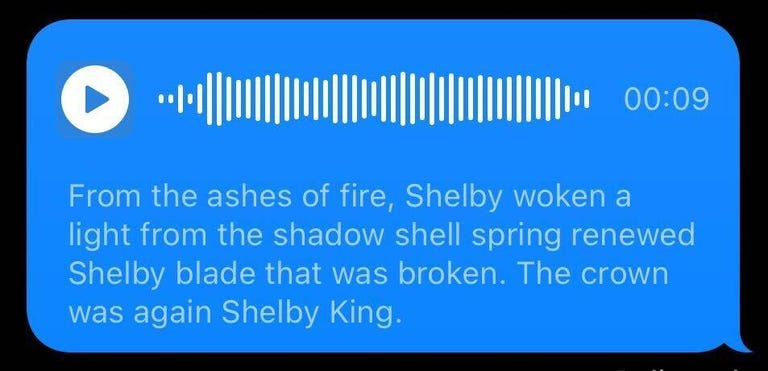Apple’s release of iOS 17 brings a handful of fun and useful features to your iPhone, like Live Stickers and offline maps. Another new feature is transcriptions of audio messages, also known as voice notes, in Messages.
Apple introduced audio messages with the release of iOS 8 in 2014. Audio messages — not to be confused with voicemail — are short audio recordings you send to someone in Messages, and they’ve become a popular way to communicate. According to a YouGov survey conducted by Vox earlier this year, 62% of Americans surveyed say they’ve sent an audio message, and about 30% of people said they use audio messages weekly. About 43% of people between the ages of 18 and 29 also said they use audio messages at least weekly.

While it might be easier to dictate a message rather than type it out, audio messages require the recipient to be in a quiet place to hear them. And unless the recipient has headphones or earbuds, audio messages might be overheard by others nearby. With iOS 17’s transcription feature, you can read your audio messages without listening to them. But how well does it work?
To find out, I had a conversation with my wife in which I exclusively used audio messages. I sent some of them with and some without without music playing in the background, too. I also read excerpts from J.R.R. Tolkien’s The Fellowship of the Ring to test the feature against uncommon words and unique names.
Here’s how to use audio message transcriptions and how well they work.
How to use audio message transcriptions
Audio message transcriptions are automatically enabled after you downloaded iOS 17. After you send the message, the transcript will appear below the audio bars.
If you receive a long audio message, the transcript might be cut off. If it is, you’ll see an arrow that you can tap to go to a new screen with the full transcript.
Results of testing audio message transcripts
There were times when my iPhone understood everything I said and transcribed it correctly, and other times when it totally butchered what I was saying.

In one conversation with my wife, I sent a message asking if we were still having chili for dinner, and my phone transcribed it perfectly. Another time, I tried to say, “I’m good, but I appreciate it though,” and what my iPhone heard was “I’m goodbye I appreciate it though.” If I read that, I might be able to figure out what it meant, but it would take me a second.
One of the excerpts I read from The Fellowship of the Ring came through well, but messed up one of the names. That’s understandable. Without some TV series, like Game of Thrones, I’d have no idea how to pronounce the names of some fantasy characters. Don’t lie to me and say you knew how to pronounce Daenerys Targaryen the first time you read it.

Another excerpt from The Fellowship of the Ring I read had no proper nouns in it, but still managed to get messed up badly. The feature injected the name “Shelby” into the transcript, making the whole passage read like gibberish. I read the excerpt back more slowly and deliberately and the transcript got most of it correct, but still mixed up some a‘s with of‘s.
Audio message transcripts didn’t seem to be affected by loud music, though. In one message I sent, you can clearly hear the group Outkast in the background, and my message was transcribed without issues and with none of the lyrics. I can’t speak to concert-level noise, but the regular level of noise you run into every day shouldn’t affect transcriptions much.
Interestingly, I tried to use Spanish in an audio message and it transcribed it, but only when my iPhone’s language was set to English. When I set my iPhone’s language to Spanish and used Spanish to send an audio message, it didn’t transcribe at all. I also tried to send a message in English while my iPhone was set to Spanish and it didn’t transcribe that message, either. I tried this with German, as well, and had similar results.
Final thoughts on audio message transcriptions
Audio message transcriptions work well enough to be understood in most cases, but Apple has some work to do to improve the feature.
Your iPhone will likely struggle with proper nouns, and if you speak quickly your words might be transformed or combined in weird ways. I also imagine that if you have an accent or if English isn’t your first language, your iPhone might have a difficult time transcribing your speech. This feature also only worked for me when my iPhone’s language was set to English, and Apple would benefit from expanding this feature to other languages.
If you’re having problems with the transcriptions, I recommend speaking slowly and enunciating every letter to help your iPhone transcribe your message better.
For more, check out CNET’s iOS 17 cheat sheet and my review of iOS 17.
